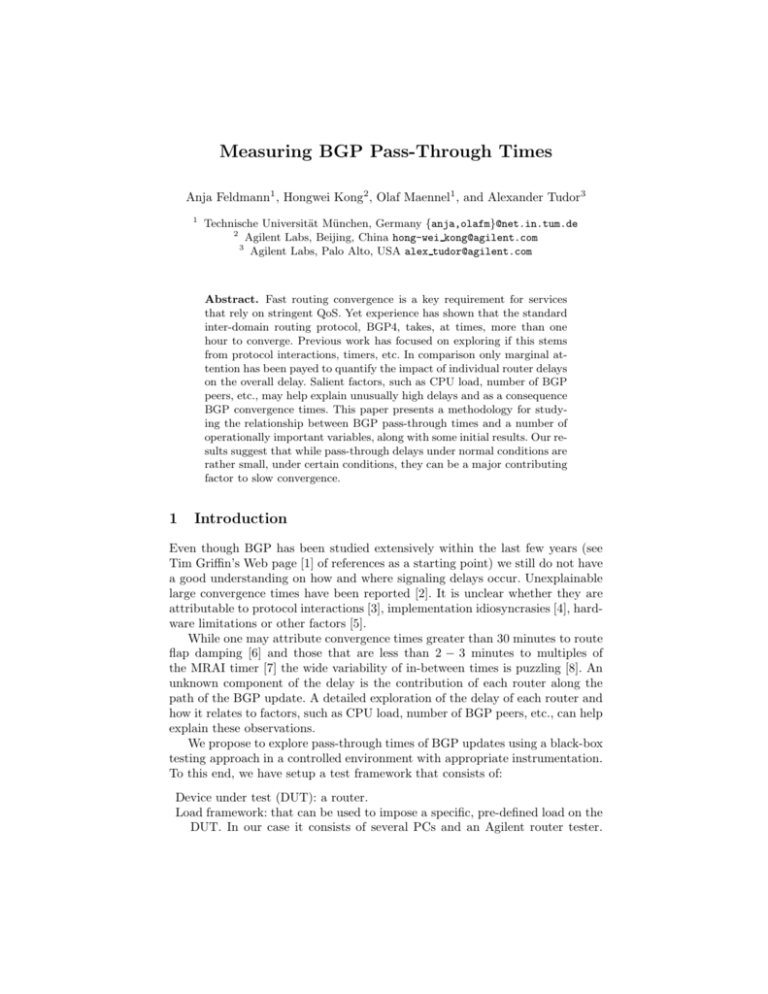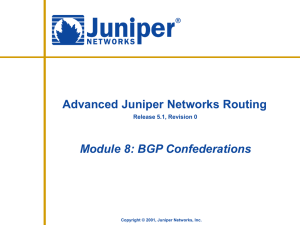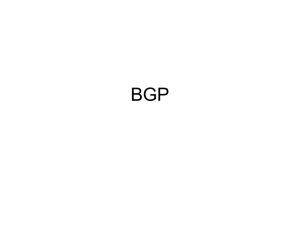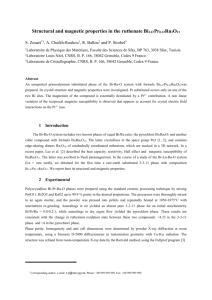Measuring BGP Pass-Through Times
advertisement

Measuring BGP Pass-Through Times
Anja Feldmann1 , Hongwei Kong2 , Olaf Maennel1 , and Alexander Tudor3
1
Technische Universität München, Germany {anja,olafm}@net.in.tum.de
2
Agilent Labs, Beijing, China hong-wei kong@agilent.com
3
Agilent Labs, Palo Alto, USA alex tudor@agilent.com
Abstract. Fast routing convergence is a key requirement for services
that rely on stringent QoS. Yet experience has shown that the standard
inter-domain routing protocol, BGP4, takes, at times, more than one
hour to converge. Previous work has focused on exploring if this stems
from protocol interactions, timers, etc. In comparison only marginal attention has been payed to quantify the impact of individual router delays
on the overall delay. Salient factors, such as CPU load, number of BGP
peers, etc., may help explain unusually high delays and as a consequence
BGP convergence times. This paper presents a methodology for studying the relationship between BGP pass-through times and a number of
operationally important variables, along with some initial results. Our results suggest that while pass-through delays under normal conditions are
rather small, under certain conditions, they can be a major contributing
factor to slow convergence.
1
Introduction
Even though BGP has been studied extensively within the last few years (see
Tim Griffin’s Web page [1] of references as a starting point) we still do not have
a good understanding on how and where signaling delays occur. Unexplainable
large convergence times have been reported [2]. It is unclear whether they are
attributable to protocol interactions [3], implementation idiosyncrasies [4], hardware limitations or other factors [5].
While one may attribute convergence times greater than 30 minutes to route
flap damping [6] and those that are less than 2 − 3 minutes to multiples of
the MRAI timer [7] the wide variability of in-between times is puzzling [8]. An
unknown component of the delay is the contribution of each router along the
path of the BGP update. A detailed exploration of the delay of each router and
how it relates to factors, such as CPU load, number of BGP peers, etc., can help
explain these observations.
We propose to explore pass-through times of BGP updates using a black-box
testing approach in a controlled environment with appropriate instrumentation.
To this end, we have setup a test framework that consists of:
Device under test (DUT): a router.
Load framework: that can be used to impose a specific, pre-defined load on the
DUT. In our case it consists of several PCs and an Agilent router tester.
II
BGP workloads can be generated by the PCs as well as the router tester.
The router tester is used to generate controlled rate data traffic. Tests are
repeated with both PC as well as router tester generated BGP workloads.
Instrumentation framework: that allows us to measure not just the pass-through
times of BGP updates but also the load imposed by the load framework.
It consists of several packet-level monitors, periodic router queries and the
router tester.
The testbed has wider applicability. For example, it can be used to explore other
router measures, such as line card FIB convergence.
Our methodology goes beyond RFC compliance tests and benchmarks, e.g.,
IETF’s BMWG [9], in that we do not consider pass-through times in isolation. Rather, we investigate the correlation between BGP pass-through time and
router load using a variety of stressors. BGP load is affected by such variables as
(1) number of peers, (2) routing table size, and (3) BGP update rate. Non-BGP
related tasks are many. We do not attempt to account for all of them individually.
Instead, we impose a specific background traffic load which causes the ip input
task’s CPU usage to increase. To measure the CPU load we periodically sample
the cumulative route processor’s load. With controlled experiments we can then
use previously obtained CPU load data to infer the BGP portion of the CPU
load. Our initial results are about establishing a baseline for pass-through times.
We also explore some aspects of stress response. A stress situation arises when
the imposed load reaches the limits of DUT.
Additional parameters that may effect pass-through time include the configured I/O queue length for BGP processes, ACLs’ complexity and hit ratio, BGP
policy settings such as route-maps, peer-groups, filter-lists and/or communities,
as well as AS prepending, etc. These are beyond the scope of this paper.
Parameter sensitivity tests and reasonable configurations were used to reduce
the otherwise many experiments, given the large number of parameter value
permutations.
Our experiments show that in general the DUT handles BGP stress well,
which is in line with recent findings [10]. Yet the per hop BGP processing delays can be significant. Updates are only processed every 200ms even when the
MRAI timer is inactive. Activating the MRAI timer adds further delay components causing higher delays occur with increasing MRAI timer values. DUT
targeted traffic, even at low data rates, drastically impacts CPU load and accordingly pass-through delays. We notice that update the rate is not nearly as
significant a factor for causing delays as is the number of peers. Yet high update
rates occurring concurrently on multiple peers, as is happening with after router
reboots, can cause problems.
The rest of the paper is structured as follows. In Section 2 we describe our
methodology for measuring pass-through times and imposing a controlled router
CPU load. Next, in Section 3, we describe in detail the configuration and tools
that constitute our test framework. We then describe our experiments and report
their results in Section 4. Section 5 concludes our paper and comments on the
III
practical learnings of this work as applied to current operational practice and
future routing protocol design.
2
Test methodology
Three topics need detailed explanation: measuring pass-through time, separating
router processing delay from MRAI timer delay, and imposing a controllable load
on the DUT.
2.1
Measuring pass-through times
There are three common approaches to network measurement: passively observing regular traffic, actively evaluating injecting traffic at end points within
the injecting application, and passively measuring actively injected traffic. Since
we operate in a testbed the first option is not applicable. Accordingly, we use
specifically designed updates as active probes together with a monitoring BGP
session. The timings of the probes and the resulting response updates generated
by the DUT and directed to the monitoring session are passively measured using
dedicated and synchronized packet capture.
Using special updates gives us the ability to impose patterns with certain
characteristics, such as ensuring that the DUT will relay it to the monitoring session. The alternative approach is to replay captured BGP update traces. While
this may provide useful background traffic it suffers from several shortcomings.
First the pass-through time of a router depends on the settings of several BGP
specific parameters such as the value of the MRAI timer. In order to distinguish
the delay due to this timer from the delay due to the router we need certain
update patterns which may or may not be present in regular BGP traces. Second, not all incoming BGP updates trigger an outgoing BGP update. Therefore
it is hard to tell which BGP updates are discarded or are combined into other
updates. Furthermore the amount of work associated with each BGP update will
vary depending on its content with respect to the router’s configuration.
The simplest form of a BGP update probe pattern is comprised of a single new prefix. Since the prefix is new, the update has to be propagated to
all neighbors and the monitor session, policy permitting. The drawback is that
the routing table size grows ad infinitum and that the available memory becomes an unintended co-variable. The table size can be controlled via explicit or
implicit withdrawals. We use implicit ones since BGP withdrawal processing differs from update processing and the results would have to be separated. Implicit
withdrawals on the other hand are indistinguishable from other updates. Each
time a probe update for a prefix is to be sent we randomly choose an AS path
length that differs from the previous path length. This ensures that the update
is propagated to the monitor session and that the quality of the path improves
or deteriorates with the same probability. The BGP update rate for both probes
and traces can be controlled. In summary probe patters are convenient for active measurements while replaying BGP traces is appropriate for generating a
realistic load on a router.
IV
Pass-through times are not constant. They vary with the makeup of the
updates and the background load caused by other factors. Accordingly, we obtain sample values by measuring the time difference between in-bound (into the
DUT) probe injections and out-bound (onto the monitoring BGP session) update propagation. To avoid time synchronization errors the packet monitors are
dedicated, line rate capable, capture only cards with highly accurate, synchronized clocks. Furthermore, all other BGP sessions are terminated on the same
machine, either the PC or the router tester.
Throughout this paper we use 10, 000 prefixes from the 96/8 range as probe
prefixes. The central part of the experiments last for 15 minutes and our probing
rate is a rather low 1 update a second. This guarantees that the TCP throughput
will never be problematic. We started by using 10 probing sessions but realized
that interactions with a periodic timer limited the accuracy of the estimates.
The periodicity of the timer in question is 200ms which with 10 probes per
second gave us only 2 samples per timer. To increase the rate of samples per
timer to 10 we increased the number of probe sessions to 50. Each probe session
uses a different random offset within the second for sending its probe. This
ensures that the probing is done at exponentially spaced but fixed intervals
within the second. A histogram of the resulting pass-through times is plotted in
Figure 1. Interestingly, the pass-through times vary from 2.4ms to about 200ms
with some ranging up to 400ms. The average pass-through time is 101ms. The
even distribution in the range of 2ms to 200ms indicates some kind of timer.
Indeed, closer inspection reveals that the router limits the update processing to
5 times a second. This should result in a theoretical upper bound on the passthrough times of 200ms. Yet some of the updates are held back for one update
processing cycle. This results in pass-through time greater than 210ms for 1.3%
of the probes.
To determine how the pass-through time compares with the one-way packet
delays we also measured the one-way delay experienced by IP packets of three
typical packet sizes (64, 576, 1500 bytes) that were sent during the same experiment, see Figure 1 for the 1500 byte packets. The average delays are, 0.028ms,
0.092ms and 0.205ms, hence, significantly shorter. This shows that a BGP update is delayed 11 times longer in the best case and 500 times longer on average
than a simple IP packet. While this might seem significant, the total accumulated delay, at 100ms a hop along a 20 hop router path, would be rather small
at under 2 seconds. This indicates that we have to consider additional factors.
2.2
MRAI timer delay
The purpose of the Min-Route Advertisement Interval timer [11] (MRAI) is to
limit the number of updates for each prefix/session for a peer to one every x
seconds. A typical value for x is 28 seconds. If the timer fires at time t − x and t
then all updates received and processed within this interval of size x are batched
and sent shortly after time t. Based on this observation an upper bound for the
pass-through time can be derived, even when the MRAI timer is active: for each
MRAI timer interval consider those probes with minimal pass-through delay. A
V
0.6
lower bound, MRAI = 5 sec
upper bound, MRAI = 5 sec
lower bound, MRAI = 30 sec
upper bound, MRAI = 30 sec
0.0
0.0
0.2
0.2
Percentages
0.4
Percentages
0.4
0.6
0.8
BGP updates
1500 byte pkts
0−0.25 0.25−2.5 2.5−50
50−100 100−150 150−200 200−250 250−400
Milliseconds
−0.05−0
0−0.05
0.05−0.1 0.1−0.25 0.25−0.5
Seconds
0.5−1
1−2
Fig. 1. Histogram of pass-through times Fig. 2. Histogram of upper and lower
together with one-way packet delays for bounds on pass-through times for MRAI
typical packet sizes 64, 576, and 1500.
values of 5 and 30 seconds.
lower bound is derivable from the probe with largest pass-through delay within
the interval. This probe arrived too late to be included in the previous MRAI
timer interval.
Figure 2 shows the histogram of the pass-through times for two different
MRAI timer values: 5s and the default Cisco value, which is roughly 30 seconds.
Note that with the MRAI timer in place the minimal measured pass-through
times are 71ms and 122ms. On the other hand the maximum values for the
lower bounds are 0.121 and 1.72 seconds! This indicates that an update might
have to wait a significant amount of time before it is processed even if it reaches
the router at a good moment. This is especially the case for larger MRAI values
where the average pass-through time increases from 109ms for the 5s MRAI
timer to 883ms for the default MRAI value. Note that each experiment is run
for the same duration. Accordingly the number of samples for the pass-through
time decreases as the MRAI value increases.
Overall it seems that even for small MRAI values the timer interactions
between MRAI and the BGP update processing timer increases the minimum
pass-through time significantly. As the MRAI value is increased the minimum
pass-through time also increases and will clearly dominate any link delays. Furthermore, inspection of the probes on the monitoring session reveals that the
order of the update probes is not maintained. This means that a probe that was
sent 10 seconds later than another might be observed earlier on the monitoring
session.
2.3
Controlled background CPU load
Imposing a controllable background CPU load on the DUT is necessary in order
to study how it responds to stress. The goal is to identify a set of tasks that
generate a constant CPU load independent of BGP. This is difficult as it implies
generating an input load that is uniformly served by a task running at a uniform
priority. This is rarely the case. In Cisco IOS the BGP processes (and any routing
VI
tasks) have higher scheduling priority than almost everything else targeted at
the CPU. The IOS ip input task is a high priority process whose CPU use is
related to the rate of a packet stream directed to the DUT’s main IP address.
Another problem is measuring the CPU load. The CPU load of a Cisco router
can be queried in two ways: via a command at the telnet interface of via an SNMP
query. Unfortunately, the default priorities of both telnet and SNMP are lower
than those of BGP and the packet processing tasks. Accordingly, for calibration
only, we raised the priority of SNMP task and then measured the CPU load both
via the command line as well as via SNMP for 5 rates: 2k, 5k, 10k, 15k pkt/s.
Both estimates aligned quite well with the only problem that the command line
interface did not deliver any values under high loads due to starvation. Figure 3
shows a histogram of the CPU load. 2k packets impose almost no load. 5k is
already significant. 10k is almost critical while 15k is well beyond critical. Note
that a 15k packet rate corresponds to a bit rate of 0.36 Mbits, which is rather
modest for a high speed interface on a high end router. This should encourage
providers to filter internal destination addresses on all incoming connections.
60
80
0 pkts/s
2,000 pkts/s
5,000 pkts/s
10,000 pkts/s
15,000 pkts/s
Traffic Capture
PC
40
Probe Updates
Source Peers
Router Tester/PC
Data Traffic Src
Background
Router Tester
Bkgrnd. Updates
Source Peers
PC
Downstream
Peers
PC
0
20
Probe Update
Monitor Peer
Router (7507)
Device Under Test
Router (12008)
0%−15%
15%−30%
30%−60% 60%−75% 75%−90% 90%−100%
Percentage of CPU load
Fig. 3. Histogram of CPU load estimates
for packet rates of 2k, 5k, 10k and 15k directed to the router IP.
3
Fig. 4. Test-bed setup for router testing.
Test framework
The testbed shown in Figure 4 illustrates its functional building blocks. The
physical layout is more complex and not shown here for the sake clarity and
brevity.
The device under test (DUT) is a Cisco 12008 GSR equipped with: 256MB
memory, 512KB of L2 cache, 200MHz GRP CPU, three Gigabit SX and 8 Fast
Ethernet interfaces. It runs IOS version 12.0(26)S. An Agilent RT900 router
tester is used for selective experiment calibration and to generate data traffic.
VII
BGP updates, probes and background, are generated by a PC. The monitoring
peer runs on a Cisco 7507. Probe update traffic from the PC into the DUT is
captured by Endace DAG cards [12]. Outgoing probe update traffic from the
DUT to the monitoring peer is also captured by an Endace DAG card. All cards
are synchronized.
The DUT is subjected to three traffic types: BGP update probes, BGP background activity updates and non-routed data traffic directed to the DUT. Probe
updates are used to compute DUT pass-through times. We create a BGP activity
noise floor by generating separate update streams, called background updates,
that are in turn propagated to multiple downstream peers. Data traffic is used to
indirectly control the CPU load and hence the time alloted to BGP processing.
DAG generated time-stamps are used to compute the DUT pass-through
time. We use tethereal to decode and reconstruct the BGP TCP sessions from
the capture files. To ease the configuration and setup of each experiment various
scripts automatically configure the PCs, the router tester, and the routers, then
start the experiments and after it is done start the evaluation. Unless specified
otherwise each experiment lasts for 15 minutes actual time but the evaluation is
not started for another 15 in order to retrieve all updates.
4
Pass-through times
Section 2 introduces our methodology for measuring pass-through times and
shows how to impose a background load on the DUT. In this section we explore
how pass-through times change as the demand on the router increases. Due to
the large number of parameters we cannot test all combinations. Rather, we
perform a number of tests to explore the variables to which pass-through times
are sensitive, including the background CPU load, the number of sessions in
combination with the BGP update rate, and the complexity of the BGP table
in combination with the BGP update rate.
More precisely in a first step we combine BGP pass-through probes with the
background CPU load. Next we increase the CPU load by adding 100/250 additional BGP sessions and a total of 500 BGP updates a second. This experiment
uses a regular pattern of updates similar to the probes. Based on this calibration
of our expectation we explore the load that is imposed by actual measured BGP
tables. The next two experiments differ in that one uses small BGP tables containing between 15, 000 - 30, 000 prefixes while the other uses large BGP tables
containing between 110, 000 - 130, 000 updates. Due to the memory requirements
of this table the number of additional sessions is reduced to 2. This provides us
with a setup to explore different BGP update rates: as fast as possible (resembles
BGP session resets), 200 updates and 20 updates a second.
4.1
Pass-through times vs. background CPU load
This set of experiments is designed to show how the background CPU load
influences the BGP pass-through delays. Accordingly we combine the approach
0.5
VIII
0.8
100 sessions, 5 updates/s, 0 pkts/s
100 sessions, 5 updates/s, 2,000 pkts/s
100 sessions, 5 updates/s, 5,000 pkts/s
250 sessions, 2 updates/s, 0 pkts/s
250 sessions, 2 updates/s, 2,000 pkts/s
0.0
0.0
0.1
0.2
Percentages
0.2
0.3
Percentages
0.4
0.6
0.4
0 pkts/s
2,000 pkts/s
10,000 pkts/s
0−0.1
0.1−0.2
0.2−0.3
Seconds
0.3−0.4
0.4−0.5
0−0.2
0.2−0.4
0.4−1
1−4
Seconds
4−10
10−40
40−88
Fig. 5. Histogram of pass-through times Fig. 6. Histogram of pass-through times
subject to different levels of background subject to different # of sessions (100/200)
traffic (0, 2k, 10k pkts/second).
and background traffic (0, 2k)).
for measuring BGP pass-through delays via active probes with that of imposing
a controlled background CPU load via a controlled packet stream directed to
the DUT’s IP address, see Section 2. We use a packet stream of 0, 2k, and 10k
packets as the first two impose no additional or just minimal load while the
latter is already almost critical.
The histogram of the resulting pass-through times is shown in Figure 5.
While the differences may at first appear minor the CPU load nevertheless has
an impact. It causes a delayed invocation of the BGP update processing task
which is reflected in the increase of the number of updates with a pass-through
time larger than 210ms. With no additional load only 1.3% of the updates are
in this category. With 2k packets this increases to 2.15% and for 10k packets to
3.73%. Note that a probe rate of 50 updates a second coupled with 5 invocations
of the BGP update processing task every second should create delays longer than
200ms for at most 10% of the probes. Overall we conclude that the increased
CPU load delays the invocation of the BGP update processing task and therefore
increases the pass-through delays. Yet, due to the timer, the delay increase is on
average rather small: from 101ms to 106ms to 110ms.
4.2
Pass-through times vs. number of sessions
This set of experiments is designed to explore if the number of sessions has
an impact on the BGP pass-through times. So far our load mix consisted of
the active BGP probes and the packets which cause a background CPU load.
Next we add additional BGP sessions (100/250) and 500 updates a second to
this mix. The simplest additional sessions are similar to our probe sessions with
the exception that we increase the update rates to 2 and 5 updates per second
respectively.
Figure 6 shows a histogram of the resulting BGP pass-through times. Interestingly adding 100 sessions poses no significant problem to the router. Yet
IX
adding 250 sessions causes way too much load on the router even without background traffic. Note that Cisco recommends to keep the number of sessions for
this specific router below 150. Adding to the 100 session experiment a background CPU load of 2k (5k) increases the CPU load from a 5 minute average
of roughly 67% to 83% and then to 95%. That CPU loads are not summable is
an indication for the possibility of saving some CPU by delaying the processing
of the BGP updates. The additional BGP sessions increase the average passthrough times to 116ms. The CPU load is then responsible for the increase to
130ms and respectively 160ms. The increase of the percentage of BGP probes
that take longer than 200ms is even more dramatic: first from 1.3% to 7.4% and
then with the packet load to 12.5% and 25.9%. Still the maximum pass-through
times are reasonable small at less than 800ms.
The further increase of the number of sessions to 250 causes a multitude
of problematic effects. First the router is no longer capable of processing the
updates so that it can send TCP acknowledgments on time. Accordingly the
number of TCP retransmissions increases from almost none, less than 0.15%, to
2.5% of the BGP probe updates. Second the number of probes propagated to the
monitoring sessions is drastically reduced. With 250 sessions the router does not
propagate updates for 39.8% of the probes. This problem is aggravated (49.2%)
by adding 2k packets of background traffic. While this reduces the number of
samples of the pass-through times their values are now in a different class with
average pass-through times of 9, 987ms and 15, 820ms. The pass-through times
increase by several orders of magnitude.
4.3
Pass-through times vs. BGP table size and update rate
So far all tests consisted of either probe updates or artificial patterns. Accordingly we now replace these artificial BGP sessions with actual BGP updates.
For this purpose we have selected two sets of two BGP routing tables dumps
from Ripe [13], one containing 37, 847/15, 471 entries and the other containing
128, 753/113, 403 entries. Note that routing tables generally differ in terms of
their address space overlap, their size and their update rate. In this preliminary
study we did not use actual updates or synthetic updates [14] with similar characteristics. Rather, since we want to study the impact of the BGP update rate
on the pass-through times for different table sizes, we opted for some regular
pattern. The first pattern, called “full-speed”, corresponds to continuous session
resets and is realized by repeatedly sending the content of the BGP table to
the router as fast as possible. The second pattern, called “100 updates/sec”, is
similar but limits the rate of updates to 100 BGP updates a second. The third
pattern, called “10 updates/sec”, further reduces the rate of updates to 10 BGP
updates a second. As it is well known that session resets impose a large load
on the router one may expect larger pass-through times. As one hopes that the
router can perform session resets at a rate of 100 updates a second the second
pattern should be simpler and not impose quite such a large load. The 10 updates a second can be expected to impose even less load than our update probes
and therefore should provide us with a base line.
X
0.8
10 updates/sec
100 updates/sec
full−speed
0.2
0−0.2
0.2−0.4
0.4−0.6
Seconds
0.6−0.8
0.0
0.0
0.2
Percentages
0.4
0.6
10 updates/sec
100 updates/sec
full−speed
Percentages
0.4
0.6
0.8
Figure 7 and 8 show the histograms of the pass-through times for experiments
with the two small tables, Figure 7, and the two larger tables, Figure 8. As
expected the pass-through times for “10 updates/sec” is with an average of
111ms for the small table only slightly increased. The impact of the large table
is visible in its average of 127ms. For the small table the full speed update rate
is significantly higher than 100 updates/sec and imposes a CPU load of 88% to
60%. This difference in terms of update rate is not as large for the full table.
Here the full patter generates a CPU load of 100% as one would hope for. For
the small table the average pass-through times increase significantly from 147ms
to 181ms. If this may not seem like much there is huge danger hiding here, the
one of missing BGP keep-alives. In both “100 updates/sec” experiments and the
“full-speed” experiment for the large table the router did not manage to send its
keep-alive in time. Therefore these experiments terminated prematurely. Overall
the maximum pass-through time in the small table experiments are reasonable
with a maximum of less than 710ms and only 35% greater than 210ms. For the
more realistic cases with the large tables this changes. Here the maximum passthrough times increase to 2.8 seconds and the percentages larger than 210ms
increases to 76%.
0−0.2
0.2−0.4
0.4−0.6
Seconds
0.6−0.8
0.8−2.8
Fig. 7. Histogram of pass-through times as Fig. 8. Histogram of pass-through times as
update rate increases (small table, 2 ses- update rate increases (large table, 2 sessions).
sions).
5
Summary
Our results show that it is possible to determine the pass-through times using a
black box testing approach. In general we found that BGP pass-through times are
rather small with average delays well less than 150ms. Yet there are situations
where large BGP convergence times may not just stem from protocol related
parameters, such as MRAI and route flap damping. The pass-through time plays
a role as well.
XI
Even when the MRAI timer is disabled and the router is otherwise idle,
periodic BGP update processing every 200ms can add as much as 400ms to the
propagation time. Increasing MRAI values appear to trigger timer interactions
between the periodic processing of updates and the timer itself which causes
progressively larger delays. For example, when using the default MRAI timer
value even the average estimate increases to 883ms but more importantly the
lower bound estimation can yield values for up to 8 seconds. This indicates that
there is an additional penalty for enabling MRAI beyond the MRAI delay itself.
Furthermore we have observed out of order arrival of updates which suggests that
using multiple prefixes for load balancing or fail-over may not always function
as expected. This bears more detailed verification.
Low packet rate data traffic targeted at the DUT can impose a critical load on
the router and in extreme cases this can add several seconds to BGP processing
delay. These results reinforce the importance of filtering traffic directed to the
infrastructure.
As expected, increasing the update rate does have an effect on processing
time, but it is not nearly as significant as adding new peers. Worth noting is
that concurrent frequent updates on multiple peers may cause problems. For
example, 53 peers generating 150 updates per second can cause the router to
miss sending a KEEPALIVE in time, thus resulting in a session reset.
Overall the in general small pass-through times indicate that the current
generation of routers may enable us to rethink some of the timer designs/artifacts
in the current BGP setup. Yet care is needed to not trigger the extreme situations
outlined above. Furthermore additional analysis is needed to better understand
the parameters affecting BGP processing rate, such as FIB updates, line card
CPU loads, BGP update contents and other configuration related parameters
already mentioned above.
References
1. T. Griffin, “Interdomain Routing Links.”
http://www.cambridge.intelresearch.net/ ∼tgriffin/interdomain/.
2. C. Labovitz, A. Ahuja, A. Bose, and F. Jahanian, “Delayed Internet routing convergence,” in Proc. ACM SIGCOMM, 2000.
3. T. G. Griffin and G. Wilfong, “An analysis of BGP convergence properties,” in
Proc. ACM SIGCOMM, 1999.
4. C. Labovitz, “Scalability of the Internet backbone routing infrastructure,” in PhD
Thesis, University of Michigan, 1999.
5. D. Wetherall, R. Mahajan, and T. Anderson, “Understanding BGP misconfigurations,” in Proc. ACM SIGCOMM, 2002.
6. Z. M. Mao, G. Varghese, R. Govindan, and R. Katz, “Route flap damping exacerbates Internet routing convergence,” in Proc. ACM SIGCOMM, 2002.
7. T. Griffin and B. J. Premore, “An experimental analysis of BGP convergence time,”
in Proc. International Conference on Network Protocols, 2001.
8. Z. M. Mao, R. Bush, T. Griffin, and M. Roughan, “BGP beacons,” in Proc. Internet
Measurement Conference, 2003.
XII
9. H. Berkowitz, E. Davies, S. Hares, P. Krishnaswamy, and M. Lepp, “Terminology
for benchmarking bgp device convergence in the control plane,” 2003. Internet
Draft (draft-ietf-bmwg-conterm-05.txt).
10. S. Agarwal, C.-N. Chuah, S. Bhattacharyya, and C. Diot, “Impact of BGP dynamics on router CPU utilization,” in Proc. Passive and Active Measurement (PAM),
2004.
11. Y. Rekhter and T. Li, “A Border Gateway Protocol 4 (BGP-4),” 1995. RFC 1771.
12. “ENDACE measurement systems.” http://www.endace.com/.
13. RIPE’s Routing Information Service Raw Data Page. http://data.ris.ripe.net/.
14. O. Maennel and A. Feldmann, “Realistic bgp traffic for test labs,” in Proc. ACM
SIGCOMM, 2002.







